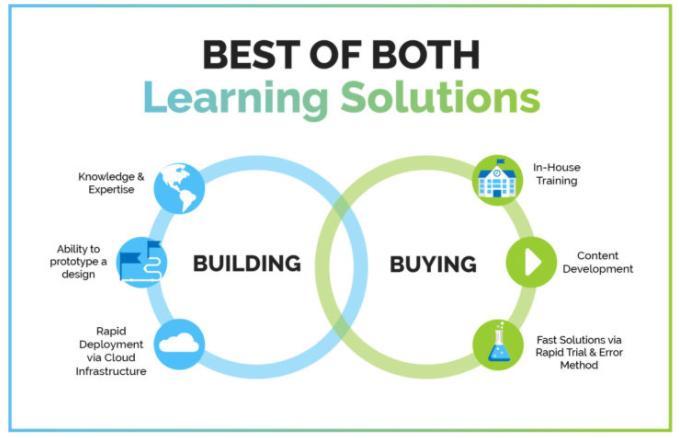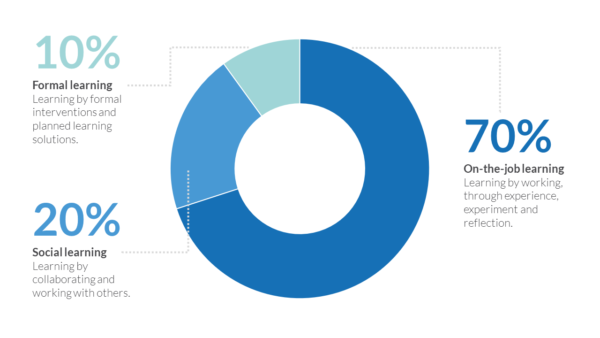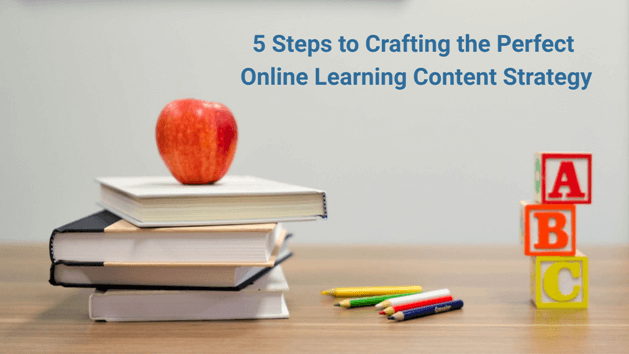From schools to businesses, the world has embraced online learning in 2020. It has allowed students to learn remotely and employees to build essential skills and adopt new business policies from home. However, you do not want to just randomly put up content. You should have a strategy.
Online content strategy has been used for a long time in marketing, but it is often non-existent in online learning spaces. Having a strategy for online learning will make your content more effective for learners, so establishing a content strategy should be a key step in your process.
This article will take you through the steps in crafting online learning strategies that will work for you. The objective is to create content that is perfect for your team and business goals. Also, you can implement these strategies to create your own e-learning website.
Step 1: Create
The first step is building the content. You need to either find or develop your content, and then get a place to house it for learners via eLearning tools. Also, you have to keep in mind that your feature image should attract the audience like a magnet that works perfectly together with your eye-catchy title. For the latter purpose, you may take advantage of various tools, like a free background remover, that stand as ready-to-go solutions requiring just a bit of customization.
There are factors in how you decide to build the content. These include:
- Subject and the ideal delivery
- Amount of content
- Amount of learners
- Audience’s base-knowledge of course material
Build it or buy it?
There are two options for creating learning content. You can build it yourself or hire someone to build it for you. To create it yourself, start by putting words to the page. The benefit of creating content yourself is that you have total control over the final product. This may allow you to provide extremely personalized experiences. However, creating this content requires time and know-how.
If you decide to have someone build it for you, you can choose an individual, a custom development shop, or buy it from a third-party content provider. An individual or a custom development shop can build what you want. They will work with you on tailoring the learning content to your needs. You can get a prototype and deploy the content rapidly.
However, the same can’t be said for content marketplaces. A client can rarely try, or even look at, the content before buying it. As a buyer, you will have no idea about the quality of the content before you have already invested resources into it. The benefits of a content marketplace, though, are that it is ready to use and provides a fast solution. Weigh your options and see if this type of content will be enough to fill your needs.

How to build content
If you decide to build custom content, you should first draft your course outline. If you go through a custom development shop or an individual, this step is essential. It will give the person creating the content an outline to make the learning content fit your learning objectives.
The learning objectives are the basic tools that underlie eLearning’s planning and activities. The first thing you must do is get a clearly defined set of learning objectives for your content. If you are building content for employee training, you can even use your own business intelligence within the platform. You can use your company’s data to guide objectives to make the content specific to your company.
Think about how you will draft your course outline around your learning objectives. List these learning objectives and other information you need your learners to know. Then group the objectives into subsections, making them look like steps. This will make your content easy to digest and give it a logical order.
It is also a good idea to place what activities and assessments you are going to assign in your outline. Activities allow your learners to absorb the information in a different way. It reinforces information you want them to learn. Assessments let you see if learners are understanding the information you have presented them. They also let the learners see their progress in the subject. Placing them in the outline gives you the opportunity to arrange them strategically throughout the course to increase learner engagement.
Then decide how you want to present your content. Will text or bullet points suffice? Or should you include videos? Also, consider your introduction carefully. You want to summarize your content while grabbing the reader’s attention.
Finally, you need to decide where you will house your content. One option is to purchase it through an LEP (Learning Experience Platform). These technologies are accessible from any device and allow users access to custom-built or premade learning content. It gives you a platform where you can illustrate your work. LEPs allow you to aggregate content: you can include internal, external, and corporate LMS (Learning Management Systems) content.
Tips
Consider working with an SME (Subject Matter Expert). They will make sure that your content is informed and up-to-date. For example, if you are providing training on effective communication while working from home, it may be good to get an expert in business communications. They will know the best tips and tricks to keep your company running smoothly.
Don’t include absolutely everything about a subject—stick to the things your learners need to know. If you give them any more than that, you risk overloading them with information they don’t need and making the course irrelevant.
Also, make the course interactive. You can:
- Use images and media
- Create digital documents with the help of flipbook software and use them as your go-to eLearning tool
- Add questions and create quizzes
- Use trivia, statistics, and interesting research
- Give out ‘homework’
- Promote discussions
Step 2: Analyze Your Content
You should always be reflecting on the content you make. Is it effective? What results are you seeing? What can you do to improve your content? This analysis is your responsibility, and you should take it seriously. It will ensure your content is working for you and your learners.
For example, if the goal of your learning content is to create a better remote work environment, check in with your users. Send them a questionnaire after they complete the course. Ask them what they found useful and what they did not. Also, check and see if their work-from-home experience has improved since the end of the course.
You can use in-content methods to analyze your material. With analytics built into your learning system, you can assess what learners are looking at, for how long, and how often. Such analysis should be ongoing throughout the use of the content. At first, you will be able to improve the content. Then you’ll need to ensure that the material is still relevant. A course created even two years ago may be obsolete with the changes in our understanding of subjects and technology.
However, you don’t have to wait until the content is widely accessible to start analyzing it. You can create focus groups to reveal insights into your content. Determine your typical learner's background and experience level to ensure that your content is targeted and effective.

If you are creating learning content for your employees, you can even do pre-assessments. These learning technologies can transform your remote team. However, you need to make sure that the content is catered to their specific needs. From pre-assessments, you can identify:
- What your learners already know
- What they need to know
- How they learn
Analyzing content allows you to make effective content. It is a step that you should never ignore. Nothing is worse than spending time and money on eLearning that isn’t allowing the users to learn and retain information. If you analyze your delivery and your content, you will have engaged learners that enjoy their experience.
Step 3: Measure Your Content
You should always measure your content for quality and relevance. This step is ongoing and requires you to adapt your content. After you analyze your data you need to take stock. Should you make changes? What kind? Do you have the most useful eLearning software for your content?
Use this step to know what you have in terms of content. If you plan on starting a new project, it will give you an idea of what you already own. You can then reuse existing content in new courses if needed. You will also be able to link to existing content if you are using internal systems of eLearning.
Questions you should ask regarding your existing material are:
- Is the material up-to-date, complete, and effective?
- Is there any performance feedback from users?
- Is the content working the way I want?
- Is there something missing?
If you are using a content marketplace, it may be more difficult to adapt your content. However, you can always use a different platform or provider. If during your analysis you find that users are not getting much from the course, you should make a change. Re-evaluate whether or not you want to build content or find another online course to buy. Measuring third-party content is just as important as measuring your own.
Step 4: Promote

Whether you are providing learning content for employees or creating a new learning system, you should promote any new content. You can do this by sending out an announcement: use email newsletters, or bring it up in your next remote meeting. And keep promoting the content. The best systems, like Duolingo, send consistent reminders to learners to return. This keeps learners engaged and attracts new users.
There are some other things you can do to promote your new content.
1. Host a webinar
This can be an essential part of attracting new users. You can share the highlights of your course and teach learners how to use the platform. If you host a webinar for your employees, you can get them excited about the opportunity to upskill. If you are creating content for a learning platform, it is a great way to start developing customer relationships.
To host a webinar, you can use several different web conferencing software and invite people to attend. If you have a VoIP phone system, you can even use that to do a video conference call with your employees.
2. Use email
Personalized emails are a great way to market your content. You can mix purely promotional emails with bonus content. If you have learners enrolled in a course, send them links to additional content they may be interested in (online videos, external or internal blogs, or relevant studies). This will help you keep in contact with your learners to keep them engaged.
Step 5: Optimize
Build upon your measuring step. Always strive to make your content better, packed with the best and latest information. Also, make your content more engaging. The more interactive you can make your content, the more information will be retained by the learners. In the end, learning content is centred around the learner, and you want to make sure you are providing the best learner experience possible.
If you are doing on-the-job training, check your ratios on how your employees are learning. Use the 70:20:10 model. You should integrate the course with daily activities, so they are getting 70% from applying the material, 20% from collaboration, and 10% from formal learning.

You also need to consider where your learners are using your course. If your course is being used by students, make sure the system is compatible with their devices. If they need storage to fully utilize the material, investigate what cloud solution for schools the students are using. This will provide you with more information on integration potential and storage capacity.
Tips
- When you optimize, make sure the content centers around the learner
- Also, consider security. If needed, research the best enterprise network security products
- Don’t stop. Always try to make your course better
- If the content is outdated, get rid of it
Takeaways
Online learning content can be a great tool for anyone looking to upskill or learn something new. From employees and students to lovers of learning, such content can provide the same level of knowledge transfer and training as a formal in-person class (and often more).
However, creating great content requires a strategy. Make sure you create relevant content based on your learners. Then analyze, measure, promote, and optimize the material. Never stop trying to be a better content provider. If you are building content for your employees, make sure it is catered to their needs. Know in advance how your employees want content delivered to them and how they learn.
If you follow these steps you will be sure to come up with winning content for both you and your learners.
Author's bio:
Sunny Dhami is the Senior Director, EMEA Product Marketing & GTM for RingCentral, a global leader in cloud communications and VoIP home phone software provider. He has extensive Marketing experience across SaaS, Telecommunications and Technology sectors within companies such as Vodafone, Reed Elsevier, Calor Gas and SapientNitro. Sunny has also written for websites such as Hubspot.





